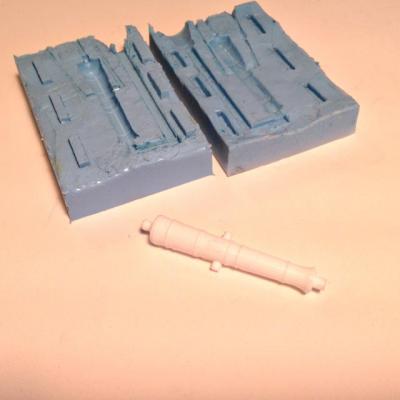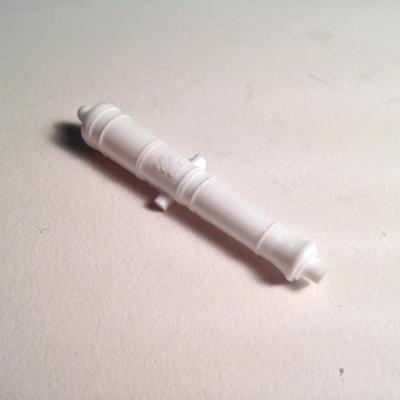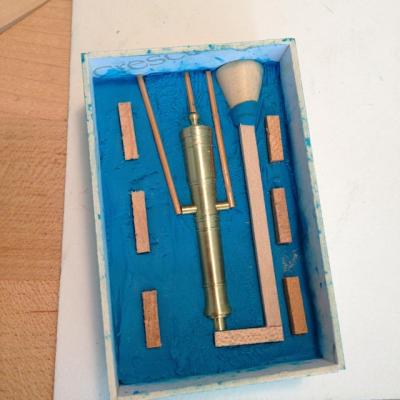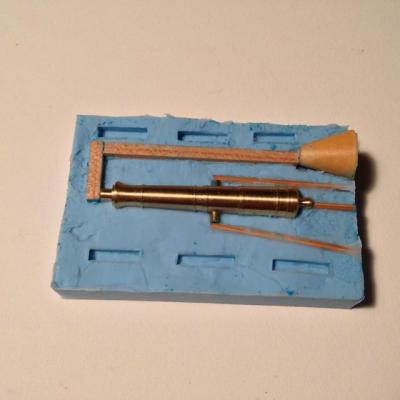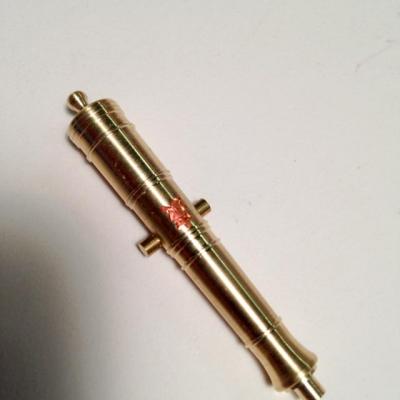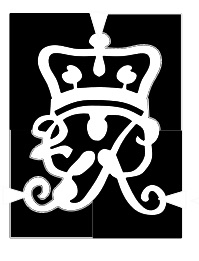-
Posts
1,649 -
Joined
-
Last visited
Content Type
Profiles
Forums
Gallery
Events
Everything posted by SJSoane
-
Hi David, it is worth jumping into, and easier than I had expected. My initial failure just gave me more encouragement to get it right next time. Siggi, your English well explains the image of pewter flying around your shop! I hope nothing got burned. I have already purchased some pewter from a jewelry supply, and will likely try casting it in the spring, when I can go outside to heat it up. I am a little bit concerned about the weight of pewter guns, and the possibility that they could break away from their mountings long after I can no longer gain access to the deck. But I assume many before me have successfully managed this. Best wishes, Mark
-
Gaetan, That is a beautifully crafted ropewalk. Can you explain a little more about the swivels? I don't see them in the first photo at the motor end. Is there only one, on the tail end with the trolley? Also, can you show the three legged top in more detail? Does it have grooves along the legs for the thread? And is the thread the Bokens linen size 110? Lots of questions, but I am fascinated with the quality of the lines you are creating. Mark
- 728 replies
-
- le fleuron
- 64 gun
-
(and 1 more)
Tagged with:
-
Remco, Your attention to this level of detail is remarkable, and so perfectly accomplished. Mark
- 1,215 replies
-
- sloop
- kingfisher
-
(and 1 more)
Tagged with:
-
Toni, Beautiful friezes. Like Remco, I have been pondering whether to paint directly onto the hull or use paper. You have shown how successful the paper approach can be! Mark
- 1,449 replies
-
Hi everyone, I have managed to cast my first cannon, more by luck than skill. Many thanks to Greg Herbert for the cypher; I have yet to accomplish a photo engraved cypher myself. I learned a great deal, but will have to do this again, since the mould line between the two halves got a little ragged, leading to leakage and also a loss of detail at the join. Here is what I learned: First, I built the initial mould box taller than the clay, which was a mistake. I was digging around from above to try to level the clay, and to push it evenly against the master. In hindsight, I see that the clay needed to be more accurately pushed up against the master. I didn't, and the first pour seeped down into the areas where the clay was not fully against the master, leaving a thin "flap" that prevented the second pour from coming cleanly against the master. Next time, I need to build a first box at the level of the clay, then build higher walls to contain the first pour of rubber (the idea can be seen in the PDF about making moulds in the resources section of this website). Second, I was using MicroMark rubber mould material that was 18 months beyond its shelf life. I don't know what it is supposed to be like within its shelf life, but one of the bottle's material was very stiff to stir at first. Indeed, I did not stir it enough for the first pour, and as a consequence it took overnight to dry and did not capture the detail as well as the second pour. I worked hard at mixing for the second pour, and added some thinner. The fidelity to the master was significantly better. I used a bottom-up feed on the mould, with the understanding that the trapped air would be pushed out a vent at the top. I poured resin until I saw it bubbling out of the center vent. That method seemed to work flawlessly, with no captured air bubbles. However, I did notice a couple of pin holes in the top of the muzzle, which i assume were bubbles created when i poured the rubber onto the master. I poured a very thin stream rubber from over a foot above the mould into a corner, understanding that this would remove bubbles thicker than the stream, and that the material would slowly flow over the master. Worked almost, not quite! Perhaps my rubber material is too thick still, and needs more thinning. If I am feeling experimental, I might try a top feed and see if it makes any difference or causes any difficulties. A top feed would certainly reduce wastage on the poured material. (I am in no rush, since I am still backing and filling, waiting for the Colorado humidity to come up in the spring so I can get back to building wales at the same humidity as the internal deck clamps.) Back to the foundry for round two... Mark
-
Karl, The rope does indeed look like full size. Spectacular! Mark
- 662 replies
-
- bonhomme richard
- frigate
-
(and 1 more)
Tagged with:
-
Gaetan, Beautiful, and what a rich tradition of decoration in French ships! Mark
- 728 replies
-
- le fleuron
- 64 gun
-
(and 1 more)
Tagged with:
-
Hi Siggi, Yes, you are right, my mistake. The barrel is indeed 10 and 12 sided. Your method worked well! Mark
-
Very elegant, Ed. Beautifully crafted. Mark
- 3,618 replies
-
- young america
- clipper
-
(and 1 more)
Tagged with:
-
Very nice, Siggi! I found it very challenging to cut the octagonal hole within the capstan head, to slide down on the barrel. You did it flawlessly. Mark
-
Ed, I am also intrigued by your sculpting epoxy. What is the brand? Beautiful, inspiring work. Mark
- 3,618 replies
-
- young america
- clipper
-
(and 1 more)
Tagged with:
-
Hi Siggi, I echo Gary's question. Do you have any photos of making the small details? They look very good. Great photos! Mark
-
Dear Gaetan, Beautiful, artistic, exquisitely crafted. You are a master. I notice your vise for holding the carving. I have seen these vises, but never how they might be used. Very ingenious. Best wishes, Mark
- 728 replies
-
- le fleuron
- 64 gun
-
(and 1 more)
Tagged with:
-
Thanks, druxey, that is a good idea. I spent the day trying fine wire, Fino modeling clay, and then some stick-on thin copper. None worked as well as the copper, which I show in a rough form here. I was thinking about casting a copy of the cannon, then adhering the thin copper to the barrel, and then engraving and cutting while it is in place. But before trying that, I will try the acrylic matt. I am learning that, at this scale, it is an impression of detail, not as defined as I thought at first. The thin wire and modeling clay were way too "chunky" for the scale of the detail and the cannon. druxey, any ideas on how I will transfer the pattern to the brass barrel? Of this this a case of free-handing with a fine awl? Best wishes, Mark
-
Thanks, Michael, this is a very good lead. I'll look up Doris' log, and track down some Fino in the morning. The etching was beginning to look like major overkill for one master.... Your machining continues to inspire me. I worked a little harder on my cannon master after seeing how you approached your project. Thanks! Mark
-
HI everyone, Well, I confidently started out trying to make the gun insignia with photo etch. I simplified the George III image, but when I print it out at 3/16" inch scale (about 1/8" long), even the simplified detail disappears. And I am not yet sure how much detail will even show after I sort out the etching process. Not so confident now! Maybe there is a better idea.... Best wishes, Mark
-
Ed, I don't know how you managed to resist the temptation to show the other hull all this time. It looks great from afar.... Mark
- 3,618 replies
-
- young america
- clipper
-
(and 1 more)
Tagged with:
-
Hi Mark, It worked for me, drilling the hole first. I then turned it at the highest RPM on the Sherline lathe, with a very shallow cut across the area with the drilled hole. I was also using the pointed cutting bit, which presumably has a smaller surface to catch if it would. I was only aware of a smallest change in sound, but no sense of anything catching. It seemed to work without difficulty. Best wishes, Mark
About us
Modelshipworld - Advancing Ship Modeling through Research
SSL Secured
Your security is important for us so this Website is SSL-Secured
NRG Mailing Address
Nautical Research Guild
237 South Lincoln Street
Westmont IL, 60559-1917
Model Ship World ® and the MSW logo are Registered Trademarks, and belong to the Nautical Research Guild (United States Patent and Trademark Office: No. 6,929,264 & No. 6,929,274, registered Dec. 20, 2022)
Helpful Links
About the NRG
If you enjoy building ship models that are historically accurate as well as beautiful, then The Nautical Research Guild (NRG) is just right for you.
The Guild is a non-profit educational organization whose mission is to “Advance Ship Modeling Through Research”. We provide support to our members in their efforts to raise the quality of their model ships.
The Nautical Research Guild has published our world-renowned quarterly magazine, The Nautical Research Journal, since 1955. The pages of the Journal are full of articles by accomplished ship modelers who show you how they create those exquisite details on their models, and by maritime historians who show you the correct details to build. The Journal is available in both print and digital editions. Go to the NRG web site (www.thenrg.org) to download a complimentary digital copy of the Journal. The NRG also publishes plan sets, books and compilations of back issues of the Journal and the former Ships in Scale and Model Ship Builder magazines.




